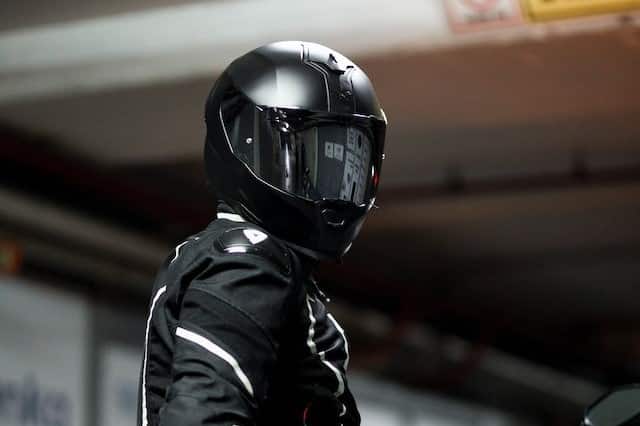How Long is a Motorcycle Helmet Good For – LIFESPAN!

You’ve had your motorcycle helmet for a while now, and you’re beginning to wonder if it’s time to trash it. Although helmets are built to be strong and tough, they won’t last forever. Helmets have lifespans; when that time has passed, they will no longer provide the level of protection you need.
So, how long is a motorcycle helmet good for before it needs replacing? I’m a motorcycle enthusiast who has used several kinds of helmets over the last two decades. In this article, I’ll explain how long a motorcycle helmet is good for and why.
Table of Contents
How Long is a Motorcycle Helmet Really Good For?
Generally, motorcycle helmets are good for about 3 to 5 years. After 5 years, they should be replaced due to potential wear and degradation of materials. Manufacturers like Arai and Shoei state that their warranty is 5 years from the date of purchase from a retailer or 7 years from the manufacture date.

Depending on usage and storage conditions, motorcycle helmets can have a shorter or longer lifespan than 5 years. As you may imagine, a poorly-stored helmet can deteriorate quickly. Also, damage from impact or a crash can accelerate how quickly your helmet’s lifespan diminishes.
You can check under the lining for your motorcycle helmet expiration date location.
When Is It Time to Replace a Motorcycle Helmet?
Assuming you can’t find your motorcycle helmet expiry date, how do you know it’s time to replace your old friend? Let’s find out the signs that your helmet needs replacing:
When It’s been 5 Years Since you First Donned the Helmet
Just like a carton of milk, your helmet has an expiration date. In general, motorcycle helmets should be replaced after five years. It is important because the materials and components that make the helmet safe can start to deteriorate and lose its protective properties.
This is especially important for helmets that are frequently exposed to extreme temperatures or direct sunlight. So, if you’re still wearing the same helmet from your first motorcycle, it might be time for an upgrade.

When you’ve taken a Spill
Replacing your motorcycle helmet if it has been involved in an accident is important. This is regardless of the severity of the accident.
According to the CDC, a quality motorcycle helmet provides 69% protection against head injuries during a crash. When damage from accidents causes the inner foam materials of the helmet to become compressed, the helmet loses its ability to absorb impacts. This puts you at risk in the event of a future accident.
Therefore, even if there are no visible signs of damage, we recommend replacing it as the integrity of the helmet may have been compromised.
When Your head has Outgrown the Helmet
As you grow and change, so do your head measurements. When your head outgrows your helmet, it may no longer sit securely on your head and move around during impact. This can reduce the effectiveness of the helmet in protecting your head and neck, increasing the risk of injury.
A too-small helmet can be uncomfortable, making it less likely that you’ll wear it regularly. Hence, replacing your helmet when your head has outgrown it is important to ensure that it fits properly and provides the maximum protection possible.
A correctly fitting helmet should sit level on your head, with the front edge no more than two finger-widths above your eyebrows.
Why You Should Replace Your Motorcycle Helmet
Here’s why it’s important to replace an expired motorcycle helmet with a new one:
Decreased Protection
An expired motorcycle may not provide adequate protection in the event of a crash. This is because the materials used in the helmet can deteriorate and lose their effectiveness. The helmet’s inner lining, padding, and straps can become worn out. This reduces its ability to absorb impacts and provide a snug fit.

Also, prolonged exposure to sunlight, heat, and moisture can weaken the helmet’s structure. This makes it less able to protect the rider in the event of a crash.
Outdated Technology
Some manufacturers update their motorcycle helmet technology annually. They add the latest safety features and advancements to ensure the helmet provides better protection for the rider.
Five years is a long time in a world that’s growing fast regarding technological advancement. If you’re using an outdated helmet, it may not have advanced safety features like sensors, cameras, and communication systems. These advanced technologies have the potential to enhance rider safety and improve the riding experience.
For example, sensors could detect when a rider is in a dangerous situation and alert them in real-time. Also, cameras and communication systems could enhance visibility and allow for better communication with other riders.
Non-Compliance with Safety Standards
Using an expired helmet may violate safety regulations and standards with could put you at legal risk. Expired motorcycle helmets are deemed non-compliant with safety standards as they no longer provide the level of protection necessary for riders.
Helmet standards are continuously evolving, and older models may no longer meet the latest safety requirements. For example, recent standards require helmets to have improved impact protection, enhanced ventilation, and improved field of vision.
An expired helmet that does not meet these standards may not provide the same level of protection as a new, certified helmet.
Decreased Comfort
Motorcycle helmets aren’t only created for protection. They also come with features that offer comfort for the rider. However, an expired helmet does not provide the same level of comfort as a new one.

An expired motorcycle helmet’s foam padding can break down and lose its ability to provide cushioning and support. This makes the helmet less comfy. Also, the interior liner of the helmet can become worn or compressed. This affects its ability to wick away sweat and keep the rider cool and dry.
Reduced Visibility
Another reason you should consider dumping your old motorcycle helmet is reduced visibility. An expired motorcycle helmet can significantly decrease the rider’s visibility. This can pose a huge threat to their safety while on the road.
Over time, the materials used in the helmet can deteriorate and become brittle. This makes it more prone to cracking or breaking in the event of an impact. Also, the sun and other elements can cause the visor to become scratched or foggy.
This can impair the rider’s vision and may cause you to miss important visual cues like other vehicles or road signs.
Check out this detailed guide by biker’s rights if you want to use wear glasses with your helmet.
FAQ
How do you tell if a helmet is expired?
All type of helmets normally have a manufacture date or expiration date stamped on them, usually located under the lining or on a sticker. If it doesn’t have an expiration date, we recommend replacing it after 5 years from the date of manufacture.
Is a 20-year-old motorcycle helmet still good?
No, a 20-year-old helmet is no longer good. We don’t recommend using a helmet over five years old, regardless of how infrequently it has been used or how well it has been cared for. Older helmets may no longer meet safety standards and could be more dangerous than not wearing a helmet at all.
Can you use an expired helmet?
No, you should not use an expired helmet. Just like many other safety products, helmets have a limited lifespan and are designed to be replaced after a certain period. The materials used in helmets can break down over time, potentially reducing their ability to protect the wearer in an accident.
Final Thoughts
Protecting your head while riding a motorcycle is a serious matter. But, you can still have a blast while being safe. If your helmet is five years or older, do not hesitate to replace it.
When you replace your expired helmet, you’re ensuring that you’re always protected by a helmet that is in good condition and fits properly. This way, you can enjoy your ride without worrying about your safety. So, gear up, rev your engine, and hit the open road with confidence!
